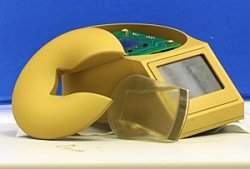ScienceDaily (Feb. 13, 2011) — Scientists from The Scripps Research Institute have shed new light on a molecular switch that turns genes on or off in response to a cell's energy needs.
The study -- published February 13, 2011 in an Advance Online Publication of the journal Nature Structural and Molecular Biology -- shows these recently discovered RNA "riboswitches" are capable of more complex functions than originally thought. In addition, because riboswitches so far have been found primarily in bacteria, the study may have implications for designing new antibiotics against harmful bacteria.
"The study provides new insights into how a single RNA molecule can integrate both positive and negative signals from a cell," said senior author Martha Fedor, an associate professor and member of the Skaggs Institute for Chemical Biology at Scripps Research. "It extends the known capabilities of riboswitches."
Riboswitches respond to the concentrations of molecules produced by a cell's metabolism -- the process of creating or using energy -- to regulate genes' activities. The new study shows that a particular riboswitch does not respond to just a single metabolite, as had been assumed, but rather to many such compounds.
Switching Genes On and Off
Each gene serves as a recipe for building a protein molecule. When a particular protein is needed by the cell, the corresponding gene, made of DNA, is turned "on," or transcribed into a messenger RNA, which then carries the "protein recipe" to the protein-making machinery of the cell.
For many years scientists thought proteins, unlike DNA and RNA, were the only molecules in a cell capable of accomplishing sophisticated tasks, such as regulating the activities of genes or carrying out chemical reactions. But in the past couple of decades, researchers have discovered that certain types of RNA molecules are adept at performing feats worthy of their protein counterparts. Riboswitches are one such example.
Discovered only about eight years ago, riboswitches are short stretches of RNA that reside within the messenger RNAs of proteins involved in a cell's metabolism. These riboswitches bind certain metabolites and, depending on how much binding occurs, the riboswitches turn the production of the corresponding proteins on or off.
Until now, most researchers had assumed a single riboswitch was specific for a single metabolite. But the new study by Fedor's group shows a riboswitch can incorporate signals from many metabolites at once.
A Self-Destructing Riboswitch
Fedor's group was interested in studying the function of a type of riboswitch that binds to a metabolite called glucosamine-6-phosphate. This amino sugar, a building block for many glyosides and glycans, is required for the cell wall and other vital structures in bacterial cells.
This particular riboswitch resides in the messenger RNA that carries instructions for the enzyme responsible for the production of glucosamine-6-phosphate, called GlmS. It was known that when glucosamine-6-phosphate is abundant in a cell, the riboswitch stops production of the GlmS enzyme by destroying itself and its messenger RNA. This self-destruction functions to shut off any more production of glucosamine-6-phosphate.
On the other hand, when glucosamine-6-phosphate concentrations are low, the glmS riboswitch does not self-destruct, keeping the messenger RNA functioning.
A Puzzling Observation
Fedor and graduate student Peter Watson had designed an assay to measure the amounts of the glmS riboswitch in yeast cells as they added increasing concentrations of glucosamine. But the scientists stumbled on a puzzling finding.
If they grew their yeast in energy-rich broth that contained glycerol, a 3-carbon energy source, the riboswitch behaved as they expected, shutting off the glmS messenger RNA in response to increasing glucosamine concentrations. However, if bacteria was grown in a broth containing glucose, a 6-carbon energy source, the riboswitch no longer self-destructed.
"At first we thought something was wrong with our system," said Fedor.
But Fedor and Watson solved the puzzle. They discovered this riboswitch can bind both glucosamine-6-phosphate and glucose-6-phosphate. Each compound, however, produces opposite results. Binding glucosamine-6-phosphate induces self-destruction of the riboswitch and turns the glmS gene off; binding glucose-6-phosphate prevents self-destruction and keeps the glmS gene turned on.
"Scientists had long focused on the ability of riboswitches to recognize a single compound, but we have now found that riboswitches, or at least this one, can recognize multiple ones," said Watson.
Integrating Signals
"When glucose concentrations are high in a cell, it means that energy is abundant," explained Watson. "That is when cells would want to grow and divide and make more glucosamine-6-phosphate to build new cell walls. But when glucosamine-6-phosphate concentrations are high, then cells know to stop making more of this compound."
The glmS riboswitch function thus depends upon a balance between these two -- and possibly additional -- competing signals. "This kind of complex signaling had long thought to be the domain of just proteins," said Fedor. "This is another example of a function thought to belong only to proteins that we now know that RNA can do."
Fedor and Watson are now testing whether other types of riboswitches use this same mechanism. Unlike the glmS riboswitch, which self-destructs, most known riboswitches regulate the activities of their respective messenger RNAs by changing their three-dimensional structures in response to metabolite binding. The new shapes act to prevent the transcription of messenger RNA or translation of messenger RNA into protein.
Although riboswitches have not yet been found in humans, Fedor believes this discovery is just a matter of time. "The great thing about the field of RNA is that we are always coming across unexpected findings," she said.
Research for the paper was funded by the National Institutes of Health and a graduate fellowship from The Skaggs Institute for Chemical Biology



